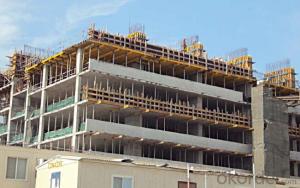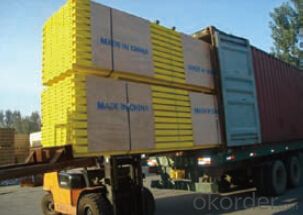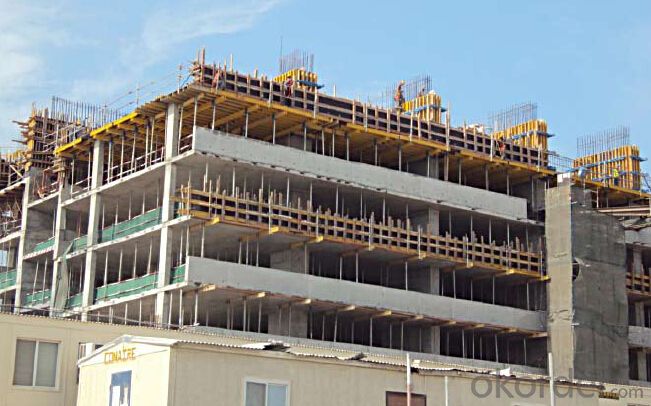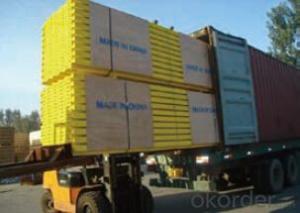Timber-Beam Formwork and H20 for formwork and scaffolding system
- Loading Port:
- Tianjin
- Payment Terms:
- TT OR LC
- Min Order Qty:
- 50 m²
- Supply Capability:
- 1000 m²/month
OKorder Service Pledge
OKorder Financial Service
You Might Also Like
Characteristics:
◆ Standardized production lines.
Supply capability: 3000m/day, Lmax = 6600mm.
◆ Finger jointing of the flange and web, the strength of timber beam is highly improved.
Max. shearing force failure load:40KN
◆ Well treated to prevent from water penetration or erosion, so the service life maximally
extended.
Normally, CNBM timber beam H20 can be used for 4 to 5 years, the exact using time would
depend on maintenance & storage.
◆ Robust caps at the end of the girders protect against damages.
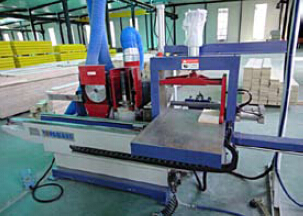
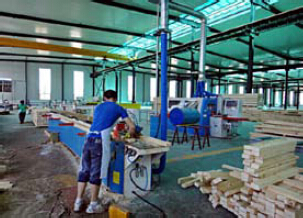

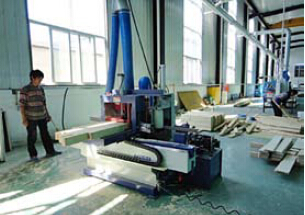
- Q: Can steel formwork be used for airport construction projects?
- Certainly, airport construction projects can make use of steel formwork. Steel formwork proves to be a versatile and long-lasting option when it comes to building various concrete structures within airports. Its attributes such as high strength, stability, and reusability offer multiple advantages, making it a suitable choice for extensive projects like airport construction. The robustness of steel formwork enables it to withstand the immense loads and pressures associated with airport infrastructure, thereby facilitating the construction of runways, taxiways, aprons, and other essential structures. Moreover, its modular design and flexibility allow for effortless customization and adaptation to cater to diverse project requirements. In summary, steel formwork emerges as a dependable selection for airport construction projects due to its durability, strength, and adaptability.
- Q: How does steel formwork contribute to the overall stability of the structure?
- Steel formwork contributes to the overall stability of a structure by providing a strong and rigid framework for concrete placement. It ensures accurate and consistent shaping of the concrete, preventing any deformations or collapses during the construction process. The steel formwork also enhances the structural integrity of the building by evenly distributing the loads and reinforcing the concrete, thereby improving its strength and durability.
- Q: Can steel formwork be used for projects with limited formwork stripping time?
- Projects with limited formwork stripping time can utilize steel formwork. Steel formwork is renowned for its durability and strength, rendering it suitable for diverse construction ventures. Unlike traditional formwork materials like wood or plywood, steel formwork can withstand higher pressures and loadings, enabling faster construction cycles. High-rise buildings, bridges, and infrastructure projects often employ steel formwork due to its time-sensitive nature. Its inflexible structure facilitates swift assembly and disassembly, minimizing formwork stripping time. Moreover, steel formwork can be reused multiple times, further diminishing construction time and expenses. Additionally, steel formwork guarantees precise dimensional control, ensuring accurate and consistent outcomes. This quality holds particular significance for projects with limited formwork stripping time since any errors or discrepancies in the formwork can result in delays and additional work. Nevertheless, it is essential to acknowledge that installing and removing steel formwork may require skilled labor and specialized equipment. Hence, meticulous planning and coordination are imperative to ensure efficient and safe utilization of steel formwork for projects with limited formwork stripping time.
- Q: What are the different types of coatings applied to steel formwork panels?
- There are several types of coatings that can be applied to steel formwork panels to enhance their durability and performance. Some of the most common coatings include: 1. Galvanized Coating: This is a popular coating choice as it provides excellent corrosion resistance. The steel panels are dipped into a bath of molten zinc, which forms a protective layer on the surface. Galvanized coatings are long-lasting and can withstand harsh weather conditions. 2. Epoxy Coating: Epoxy coatings are widely used to protect steel formwork panels from corrosion and chemical damage. These coatings are applied as a two-part system, where a primer is first applied to the surface and then a topcoat is added. Epoxy coatings offer high resistance to chemicals, abrasion, and impact. 3. Powder Coating: Powder coating is a dry finishing process where a free-flowing, dry powder is electrostatically applied to the steel formwork panels. The coated panels are then heated, causing the powder to melt and form a durable and hard finish. Powder coatings provide excellent resistance to impact, chemicals, and UV rays. 4. Paint Coating: Paint coatings are widely used to enhance the aesthetic appeal of steel formwork panels. These coatings are typically applied in multiple layers, including a primer, intermediate coat, and topcoat. Paint coatings can provide basic corrosion protection, but may require regular maintenance and touch-ups. 5. Concrete Release Coating: This type of coating is specifically designed to prevent concrete from sticking to the steel formwork panels. It creates a smooth, non-stick surface that allows for easy removal of the cured concrete. Concrete release coatings are typically based on silicone or wax compounds. It is important to choose the appropriate coating for steel formwork panels based on the specific requirements of the project, including the desired level of corrosion resistance, aesthetics, and durability. Consulting with a coatings expert or a steel manufacturer can help in selecting the most suitable coating for the intended application.
- Q: What are the considerations when designing steel formwork for foundations?
- When designing steel formwork for foundations, there are several important considerations that need to be taken into account. Firstly, the load-bearing capacity of the formwork needs to be carefully calculated and designed to ensure it can support the weight of the concrete being poured. The formwork must be able to withstand the pressure and weight of the liquid concrete without deforming or collapsing. The strength and thickness of the steel used for the formwork will play a crucial role in determining its load-bearing capacity. Another consideration is the shape and size of the foundation. The formwork needs to be designed to accurately replicate the desired shape and dimensions of the foundation. This requires careful planning and measurement to ensure the formwork is properly aligned and positioned before pouring the concrete. Any inaccuracies in the formwork can result in a foundation that is not level or properly aligned, which can compromise the structural integrity of the entire building. Furthermore, the formwork needs to be designed with the ease of installation and removal in mind. Steel formwork systems that are modular or adjustable can greatly improve the efficiency of the construction process. This allows for easy assembly and disassembly of the formwork, reducing labor and time requirements. Additionally, provisions should be made for easy access to the foundation for any necessary inspections or repairs during and after construction. Lastly, the durability and longevity of the steel formwork should be considered. Steel is known for its strength and durability, but precautions should still be taken to protect the formwork from environmental factors such as corrosion. Applying protective coatings or using galvanized steel can help prevent rust and extend the lifespan of the formwork. In summary, when designing steel formwork for foundations, considerations such as load-bearing capacity, accuracy of shape and size, ease of installation and removal, and durability are vital to ensure a successful and structurally sound foundation.
- Q: What are the features of the new building template?
- No ne1, long service life. Service life is 3 times the old template.2, low cost. Compared with the original old template, the cost per square meter decreased by 35%.3, strong, firm, high compressive strength. The pressure capacity per square meter is 2 times the old steel formwork.4, once pouring molding, no need to re plastering processing, improve the construction speed, and save construction costs.5, demolition, easy installation.ed to be used again after the molding process. The periphery of the template with plate fixation, and a groove can be inserted, the template is extended.
- Q: How does steel formwork handle formwork stripping?
- Formwork stripping is made easier with the use of steel formwork, which provides a sturdy and durable framework capable of withstanding the forces involved in its removal. Designed to be rigid and stable, steel formwork allows for efficient stripping once the concrete has cured. To remove the formwork panels or components from the concrete structure, the fasteners or connectors holding the formwork in place can be loosened. Steel formwork is commonly assembled with bolts, nuts, or other mechanical connectors, which can be easily undone during the stripping process. One advantage of using steel formwork is the smooth and clean surfaces it offers, minimizing the risk of concrete adhering to it while pouring and curing. This results in a simpler stripping process, as the concrete is less likely to stick to the steel surface. Moreover, the smooth surface allows for effortless cleaning and maintenance, ensuring its longevity and reusability. Additionally, steel formwork is renowned for its high strength and ability to bear heavy loads, allowing it to support the weight of the concrete during pouring and curing. This strength is also beneficial during the stripping process, as the steel formwork can withstand the pressure and forces involved without deforming or collapsing. Overall, steel formwork proves to be a reliable and efficient solution for formwork stripping. Its strength, durability, and user-friendliness make it a popular choice in construction projects that require quick and safe removal of formwork.
- Q: What are the common safety certifications for steel formwork?
- There are several common safety certifications for steel formwork used in construction projects. These certifications ensure that the steel formwork meets specific safety standards and regulations. One of the most well-known certifications is the OSHA (Occupational Safety and Health Administration) certification. This certification ensures that the steel formwork complies with the safety regulations set forth by OSHA. It covers various aspects such as stability, load-bearing capacity, and structural integrity. Another widely recognized certification is the ANSI (American National Standards Institute) certification. ANSI provides standards for construction equipment and materials, including steel formwork. This certification ensures that the formwork meets the necessary safety requirements, including strength, durability, and stability. The European standard EN 12812 is also an important certification for steel formwork used in Europe. It sets out the requirements for formwork systems and verifies their safety and performance. This certification covers aspects such as load-bearing capacity, stability, and safety factors. Additionally, the International Organization for Standardization (ISO) provides certifications related to steel formwork safety. The ISO 9001 certification ensures that the manufacturer has a quality management system in place, while the ISO 45001 certification focuses on occupational health and safety management systems. Other specific certifications may be required depending on the country or region. For example, in the United Kingdom, the British Standards Institution (BSI) certification may be necessary. Overall, these safety certifications for steel formwork provide assurance to construction professionals that the formwork they are using meets the necessary safety standards and regulations. It is essential to ensure that the steel formwork used on construction sites holds these certifications to prevent accidents, ensure worker safety, and maintain the structural integrity of the formwork.
- Q: Can steel formwork be used for curved or irregular-shaped structures?
- Indeed, curved or irregular-shaped structures can be constructed using steel formwork. Unlike conventional timber formwork, steel formwork boasts enhanced flexibility and strength, rendering it ideal for intricate shapes and designs. With steel formwork, it is effortless to bend or fabricate it into any desired shape, facilitating the construction of curved walls, columns, and slabs. Furthermore, steel formwork delivers exceptional support and stability, guaranteeing the precision and accuracy of the eventual structure. Its durability and reusability further contribute to its cost-effectiveness in projects involving curved or irregular-shaped structures.
- Q: What are the characteristics of steel formwork
- 5, good insulation performance, is conducive to the preservation of concrete in winter.6, easy maintenance, can be repaired in the local damage surface, when one side wear, you can flip the use of the plate.
Send your message to us
Timber-Beam Formwork and H20 for formwork and scaffolding system
- Loading Port:
- Tianjin
- Payment Terms:
- TT OR LC
- Min Order Qty:
- 50 m²
- Supply Capability:
- 1000 m²/month
OKorder Service Pledge
OKorder Financial Service
Similar products
Hot products
Hot Searches
Related keywords

